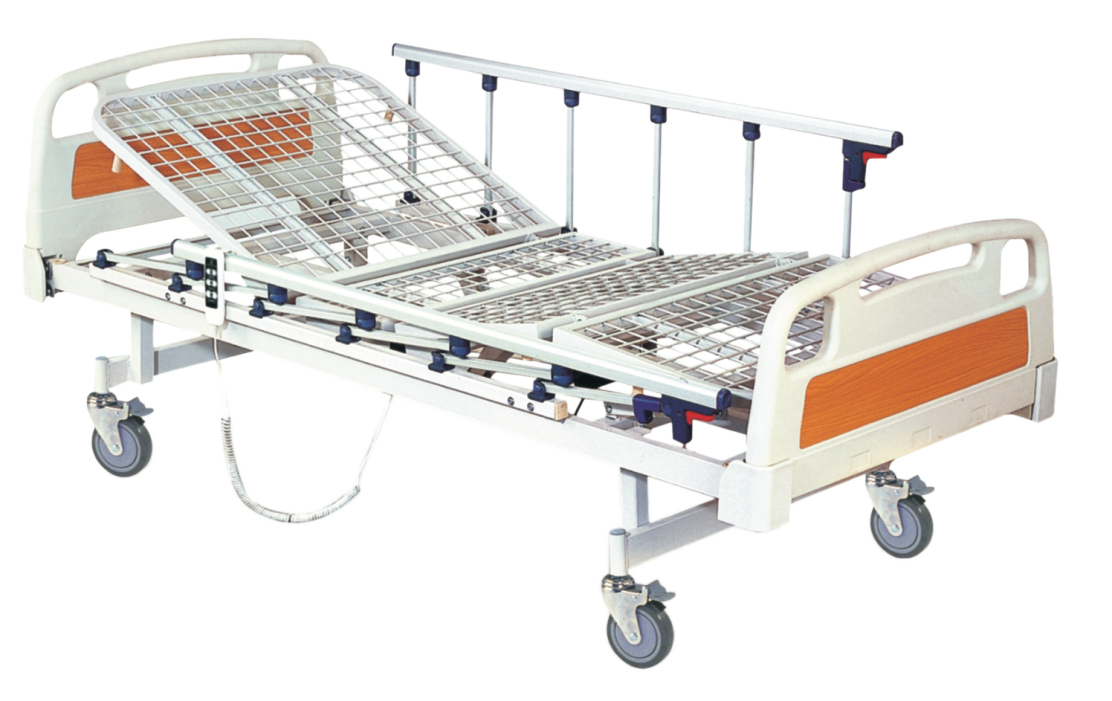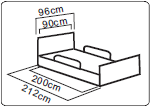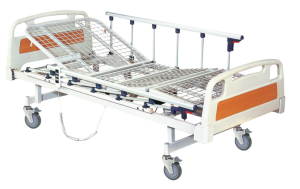Description
- Two adjustment, metal net board.
- Detachable ABS head and end bed-boards.
- Aluminum removable guardrails.
- Powder coating steel frame.
- Double handle knobs.
What is a Hospital Bed?
A hospital bed is a bed specifically designed for hospitalized patients or for those who need medical care. They are often found in hospitals, nursing homes, and other medical facilities. Hospital beds can be either manual or electronic, and they come in a variety of sizes and shapes. There are many factors to consider when choosing a hospital bed, such as the patient's needs, the size and layout of the room, and the budget. The type of bed you choose will also depend on the type of care the patient needs. For example, if the patient is recovering from surgery, they will need a different type of bed than if they are being treated for a chronic illness. Here are some things to keep in mind when choosing a hospital bed: - The patient's needs: What type of care does the patient need? Are they recovering from surgery or an injury? Do they have a chronic illness? - The size and layout of the room: How much space do you have for the bed? Is the room private or shared? - The budget: How much can you afford to spend on a hospital bed?
Important Factors to Consider in Choosing a Hospital Bed
There are a number of factors to consider when choosing a hospital bed. These include the type of bed, the size and weight capacity, the height and adjustability, and the features. The type of bed is an important factor to consider. There are four main types of hospital beds: electric, manual, bariatric, and low air loss. Electric beds are most common in hospitals as they allow for easy adjustments to the head, foot, and height of the bed. Manual beds are less expensive but require more effort to adjust. Bariatric beds are designed for patients who are obese or overweight. Low air loss beds provide pressure relief and are often used for patients with wounds or skin conditions. The size and weight capacity of the bed are also important factors to consider. Hospital beds come in a variety of sizes, from twin to full-size. They also have different weight capacities, so it is important to choose a bed that can accommodate the patient's weight. The height and adjustability of the bed are other important factors to consider. The height of the bed should be comfortable for the patient to get in and out of. The bed should also be adjustable so that the patient can find a position that is comfortable for them. The features of the bed are also important factors to consider. Hospital beds come with a variety of features, such as bed rails, IV poles, and footboards. Some beds also have built-in storage areas, which can be useful for storing medical supplies or personal belongings.
Types of Hospital Beds
There are many different types of hospital beds that you can choose from. The most common type of hospital bed is the semi-electric bed. This type of bed has an electric motor that allows you to adjust the head and foot of the bed. This type of bed is the most popular because it is very affordable and it is easy to use. The next type of hospital bed is the full-electric bed. This type of bed has an electric motor that allows you to adjust the whole bed. This type of bed is more expensive than the semi-electric bed, but it is much easier to use. The last type of hospital bed is the manual bed. This type of bed does not have an electric motor and you have to adjust the head and foot of the bed manually. This type of bed is more affordable than the full-electric bed, but it is not as easy to use.
Comfort and Safety Features of Hospital Beds
When you are hospitalized, the last thing you want to worry about is whether or not your bed is comfortable. But comfort should be one of your top priorities when choosing a hospital bed. After all, you will be spending a lot of time in it!
There are many different types of hospital beds on the market, so how do you know which one is right for you? Here are some things to look for:
1. Adjustability: Can the bed be raised or lowered to accommodate your needs? This is important for both comfort and safety.
2. Side Rails: Side rails can help prevent you from falling out of bed and can also provide support when you are getting in and out of bed.
3. Firmness: A firm mattress is important for preventing bed sores. However, it should not be so firm that it is uncomfortable.
4. Safety Features: Look for a hospital bed with features like an emergency brake and lock system to keep you safe while in the hospital.
5. Warranty: Choose a hospital bed that comes with a warranty so that you can be sure it will last.
Choosing the Right Size for your Bed
When shopping for a new hospital bed, one of the most important factors to consider is the size of the bed. You'll want to make sure that the bed you choose is the right size for your specific needs. Here are a few things to keep in mind when choosing the right size hospital bed:
-The height of the bed. You'll want to make sure that the bed is tall enough so that you can easily get in and out of it.
-The width of the bed. You'll want to make sure that the bed is wide enough so that you can comfortably sleep in it.
-The length of the bed. You'll want to make sure that the bed is long enough so that you can stretch out and move around in it.
Once you've considered these factors, you'll be well on your way to finding the perfect hospital bed for your needs!







